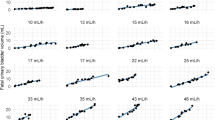Abstract
Objective
The aim of the present study was to establish the normal range for fetal UPR in the Brazilian population.
Methods
A cross-sectional study was performed in 167 normal singleton fetuses with gestational ages ranging from 20 to 40 weeks. UPR was measured using 3-D US virtual organ computer-aided analysis (VOCAL). UPR (in ml/h) was calculated during the filling phase by using the equation UPR = (VFB2 − VFB1)/time. The values for UPR were plotted as a function of gestational age to obtain a nomogram. Interobserver reliability was also investigated by using Spearman’s rank correlation for comparison of paired samples in cases of replication between observers. Bland and Altman’s graphical approach was utilized to investigate the agreement between observers.
Results
A total of 167 normal singleton fetuses with gestational age between 20 and 40 weeks were investigated. Nine of them were excluded because the image quality was insufficient for correct visualization of the bladder contour. Linear regression analysis of UPR as a function of gestational age generated a curve that represents the normal range for fetal UPR in the Brazilian population, and is expressed by the equation: Ln (UPR) = −13.7508 + 0.7094 × GA − 0.0092 × GA2 (R 2 0.60). A correlation coefficient of 0.9994 (Spearman) was obtained. Bland and Altman’s graphic plots confirm the significant agreement between observers.
Conclusion
Small differences were observed between the values for UPR observed in our sample and the normal values described in previous studies. These differences were observed mainly in late third trimester and are probably related to population biometric differences.


Similar content being viewed by others
References
Beall MH, van den Wijngaard JP, van Gemert MJ et al (2007) Amniotic fluid water dynamics. Placenta 28:816–823
Oberg KC, Pestaner JP, Bielamowicz L, Hawkins EP (1999) Renal tubular dysgenesis in twin–twin transfusion syndrome. Pediatr Dev Pathol 2:25–32
Bajoria R, Ward S, Sooranna SR (2001) Atrial natriuretic peptide mediated polyuria: pathogenesis of polyhydramnios in the recipient twin of twin–twin transfusion syndrome. Placenta 22:716–724
Magann EF, Doherty DA, Ennen CS et al (2007) The ultrasound estimation of amniotic fluid volume in diamniotic twin pregnancies and prediction of peripartum outcomes. Am J Obstet Gynecol 196:570 e1–e8
Lee SM, Park SK, Shim SS et al (2007) Measurement of fetal urine production by three-dimensional ultrasonography in normal pregnancy. Ultrasound Obstet Gynecol 30:281–286
Touboul C, Boulvain M, Picone O et al (2008) Normal fetal urine production rate estimated with 3-dimensional ultrasonography using the rotational technique (virtual organ computer-aided analysis). Am J Obstet Gynecol 199:57 e1–e5
Yamamoto Y, Essaoui M, Nasr B et al (2007) Three-dimensional sonographic assessment of fetal urine production before and after laser surgery in twin-to-twin transfusion syndrome. Ultrasound Obstet Gynecol 30:972–976
Touboul C, Picone O, Levaillant JM, Boithias C, Frydman R, Boulvain M, Senat MV (2009) Clinical application of fetal urine production rate in unexplained polyhydramnios. Ultrasound Obstet Gynecol 34:521–525
Campbell S, Wladmiroff JW, Dewhurst CJ (1973) The antenatal measurement of fetal urine production. J Obstet Gynecol Br Commonw 80:680–686
Hendriana HL, Moore TR (1994) Ultrasonographic evaluation of human fetal urinary flow rate: accuracy limits of bladder volume estimations. Am J Obstet Gynecol 170:1250–1254
Peixoto-Filho FM, Sa RA, Lopes LM et al (2007) Three-dimensional ultrasound fetal urinary bladder volume measurement: reliability of rotational (VOCAL) technique using different steps of rotation. Arch Gynecol Obstet 276:345–349
Kusanovic JP, Nien JK, Gonçalves LF et al (2008) The use of inversion mode and 3D manual segmentation in volume measurement of fetal fluid filled structures: comparison with virtual organ computer-aided analysis (VOCAL™). Ultrasound Obstet Gynecol 31(2):177–186
Conflict of interest statement
None.
Author information
Authors and Affiliations
Corresponding author
Rights and permissions
About this article
Cite this article
Peixoto-Filho, F.M., de Sá, R.A.M., Velarde, L.G.C. et al. Normal range for fetal urine production rate by 3-D ultrasound in Brazilian population. Arch Gynecol Obstet 283, 497–500 (2011). https://doi.org/10.1007/s00404-010-1397-1
Received:
Accepted:
Published:
Issue Date:
DOI: https://doi.org/10.1007/s00404-010-1397-1




